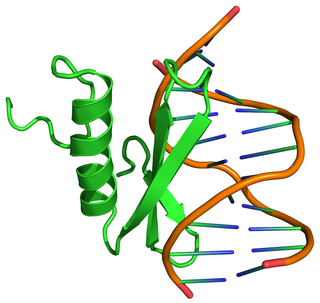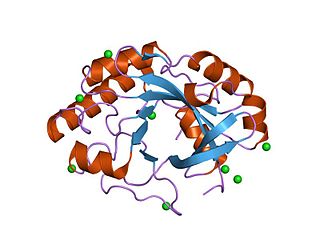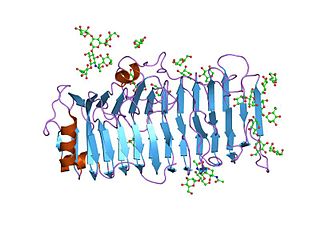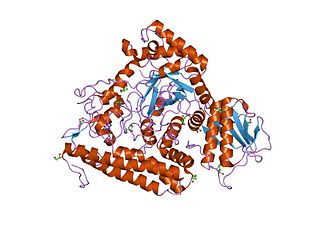
Glycoside hydrolases catalyze the hydrolysis of glycosidic bonds in complex sugars. They are extremely common enzymes with roles in nature including degradation of biomass such as cellulose (cellulase), hemicellulose, and starch (amylase), in anti-bacterial defense strategies, in pathogenesis mechanisms and in normal cellular function. Together with glycosyltransferases, glycosidases form the major catalytic machinery for the synthesis and breakage of glycosidic bonds.
Expansin refers to a family of closely related nonenzymatic proteins found in the plant cell wall, with important roles in plant cell growth, fruit softening, abscission, emergence of root hairs, pollen tube invasion of the stigma and style, meristem function, and other developmental processes where cell wall loosening occurs. Expansins were originally discovered as mediators of acid growth, which refers to the widespread characteristic of growing plant cell walls to expand faster at low (acidic) pH than at neutral pH. Expansins are thus linked to auxin action. They are also linked to cell enlargement and cell wall changes induced by other plant hormones such as gibberellin, cytokinin, ethylene and brassinosteroids.

Ethylene-responsive element binding protein(EREBP) is a homeobox gene from Arabidopsis thaliana and other plants which encodes a transcription factor. EREBP is responsible in part for mediating the response in plants to the plant hormone ethylene.
Arabinogalactan-proteins (AGPs) are highly glycosylated proteins (glycoproteins) found in the cell walls of plants. Each one consists of a protein with sugar molecules attached. They are members of the wider class of hydroxyproline (Hyp)-rich cell wall glycoproteins, a large and diverse group of glycosylated wall proteins.
CAZy is a database of Carbohydrate-Active enZYmes (CAZymes). The database contains a classification and associated information about enzymes involved in the synthesis, metabolism, and recognition of complex carbohydrates, i.e. disaccharides, oligosaccharides, polysaccharides, and glycoconjugates. Included in the database are families of glycoside hydrolases, glycosyltransferases, polysaccharide lyases, carbohydrate esterases, and non-catalytic carbohydrate-binding modules. The CAZy database also includes a classification of Auxiliary Activity redox enzymes involved in the breakdown of lignocellulose.

In molecular biology, a carbohydrate-binding module (CBM) is a protein domain found in carbohydrate-active enzymes. The majority of these domains have carbohydrate-binding activity. Some of these domains are found on cellulosomal scaffoldin proteins. CBMs were previously known as cellulose-binding domains. CBMs are classified into numerous families, based on amino acid sequence similarity. There are currently 64 families of CBM in the CAZy database.

In molecular biology, Glycoside hydrolase family 14 is a family of glycoside hydrolases.

In molecular biology, Glycoside hydrolase family 19 is a family of glycoside hydrolases.

In molecular biology, Glycoside hydrolase family 2 is a family of glycoside hydrolases.

In molecular biology, glycoside hydrolase family 25 is a family of glycoside hydrolases.

In molecular biology, glycoside hydrolase family 28 is a family of glycoside hydrolases.
In molecular biology, glycoside hydrolase family 43 is a family of glycoside hydrolases.

In molecular biology, glycoside hydrolase family 45 is a family of glycoside hydrolases.

In molecular biology, glycoside hydrolase family 56 is a family of glycoside hydrolases.

In molecular biology, glycoside hydrolase family 67 is a family of glycoside hydrolases.
In molecular biology, glycoside hydrolase family 70 is a family of glycoside hydrolases.
In molecular biology, glycoside hydrolase family 72 is a family of glycoside hydrolases.
In molecular biology, glycoside hydrolase family 79 is a family of glycoside hydrolases.
In molecular biology, glycoside hydrolase family 97 is a family of glycoside hydrolases.

In molecular biology, glycoside hydrolase family 22 is a family of glycoside hydrolases.











